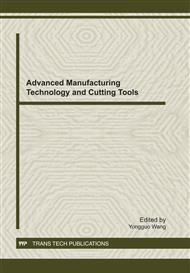p.11
p.16
p.20
p.25
p.30
p.34
p.38
p.44
p.48
Investigation on Peaming Process of PCD Tool when Reaming Aluminium Cast Alloys
Abstract:
An experimental investigation on the unique reaming behavior of aluminium cast alloys (AlSi12) by using PCD (polycrystalline diamond) tools has been studied. The torque has been monitored in real time during reaming process and the average values of torque were calculated by using FFT (Fast Fourier Transform) filtering. The optimized cutting parameters are provided in terms of analyzing the cutting torque, hole diameter and cylindricity. Results show that the torque initial increases with the rising cutting speed but subsequently decreases when the cutting speed reach to 6000r/min. It is also notable that the optimization of machining parameters basing on cylindricity are that when the cutting speed is under 6000r/min, smaller cutting feed is recommended, while when the cutting speed is over 6000r/min, higher cutting feed is appropriate.
Info:
Periodical:
Pages:
30-33
Citation:
Online since:
November 2011
Authors:
Keywords:
Price:
Сopyright:
© 2012 Trans Tech Publications Ltd. All Rights Reserved
Share:
Citation:


